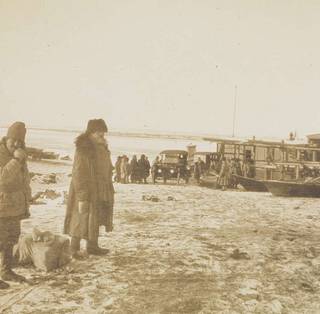
Similar
No-nb bldsa 6a024 - Norway. Public domain image
Summary
Norsk bokmål: Landet i Markstadtregionen, der det er hungersnød blant den tyske minoritet. Fridtjof Nansen reiste fra Saratov sammen med sitt følge i to biler, som her forlater fergen. Ett av bildene fra reisen til Russland i november og desember 1921. På oppdrag fra Det Internasjonale Røde Kors besøkte Fridtjof Nansen områder som ble hardest rammet av hungersnøden.
English: The countryside in the Markstadt region, where there was famine among the German minority. Fridtjof Nansen and his company travelled from Saratov in two cars, here seen leaving the ferry. One of the pictures from Russia in November and December 1921. On assignment from the International Red Cross, Fridtjof Nansen visited the regions that were the hardest hit by famine.
Deutsch: Das Land in der Markstadtregion, wo unter der deutschen Minorität Hungersnot herrscht. Fridtjof Nansen reiste von Saratov zusammen mit seinem Gefolge in zwei Autos, die hier die Fähre verlassen. Eines der Bilder von der Reise nach Russland im November und Dezember 1912. Im Auftrag vom Internationalen Roten Kreuz besuchte Fridtjof Nansen die Gebiete, die am meisten von der Hungernot betroffen waren.
Español: El campo en la región de Markstadt donde la minoria alemana sufre hambre. Fridtjof Nansen y su comitiva viajaron de Saratov en dos coches que en esta foto salen del transbordador. Una de las fotos del viaje a Rusia en noviembre y diciembre de 1921. Como encargado de la Cruz Roja Internacional, Fridtjof Nansen visitó las zonas que fueron más duramente castigadas por el hambre.
Nederlands: Platteland van het gebied Markstadt, waar de Duitse minderheid aan honger leed. Fridtjof Nansen en zijn collega's kwamen vanuit Saratov met twee auto's. In de foto verlaten ze de veerboot. Een foto uit Rusland van november en december 1921. Het Internationale Rode Kruis stuurde Fridtjof Nansen naar de gebieden die het meest door voedseltekort waren getroffen.
Depicted place: Russland, Marks
Fridtjof Nansen was a Norwegian explorer, scientist, diplomat, and humanitarian. He is best known for his expeditions to the Arctic and his work on behalf of refugees during and after World War I. The Nansen Photographs tells the story of the Norwegian Arctic explorer and his ground-breaking effort to reach the North Pole in the specially-designed polar ship Fram and his later life as a diplomat. Nansen was born in 1861 and studied zoology at the University of Christiania (now called the University of Oslo). He made several expeditions to the Arctic, including a journey across Greenland on skis in 1888 and an expedition to explore the Arctic Ocean in 1893-1896. Nansen also made significant contributions to the fields of oceanography and meteorology and was a pioneer in the study of the Earth's magnetic field. Some of his most notable achievements include: Arctic exploration: Nansen made several expeditions to the Arctic, including a journey across Greenland on skis in 1888 and an expedition to explore the Arctic Ocean in 1893-1896. His expeditions helped to advance the field of polar exploration and contributed to our understanding of the Arctic environment and the people who live there. Science and research: Nansen made significant contributions to the fields of oceanography and meteorology and was a pioneer in the study of the Earth's magnetic field. He also conducted research on the biology and behavior of marine animals, including the study of whale migration patterns. Diplomacy and humanitarian work: Nansen served as a Norwegian delegate to various international conferences and negotiations, and was appointed as the League of Nations' first High Commissioner for Refugees in 1922. In this role, he worked on behalf of refugees and displaced persons following World War I, and he was awarded the Nobel Peace Prize in 1922 for his efforts to improve the situation of refugees and displaced persons. Later in his life, Nansen worked as a diplomat and was appointed as the League of Nations' first High Commissioner for Refugees in 1922. He was awarded the Nobel Peace Prize in 1922 for his work on behalf of refugees and displaced persons. One of Nansen's main responsibilities as High Commissioner was to work with the Soviet Union to facilitate the return of prisoners of war and civilians who had been held in Russia during the war. Nansen met with Bolshevik leaders, including Vladimir Lenin, in an effort to negotiate the release of these prisoners and facilitate their return to their home countries. In addition to his work on behalf of refugees, Nansen also engaged in diplomatic efforts to improve relations between the Soviet Union and the international community. He met with Bolshevik leaders on several occasions to discuss issues of mutual concern and worked to promote cooperation and understanding between the Soviet Union and other nations. Nansen died in 1930, but his legacy as an explorer, scientist, and humanitarian continues to be recognized and celebrated around the world.
Tags
Date
Source
Copyright info


















